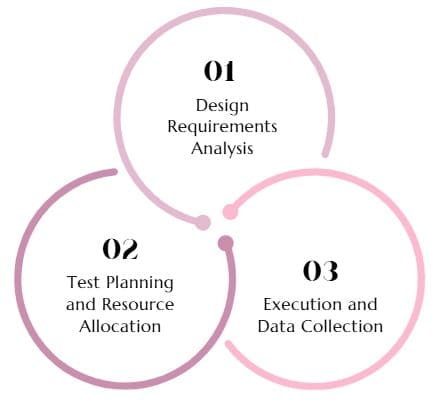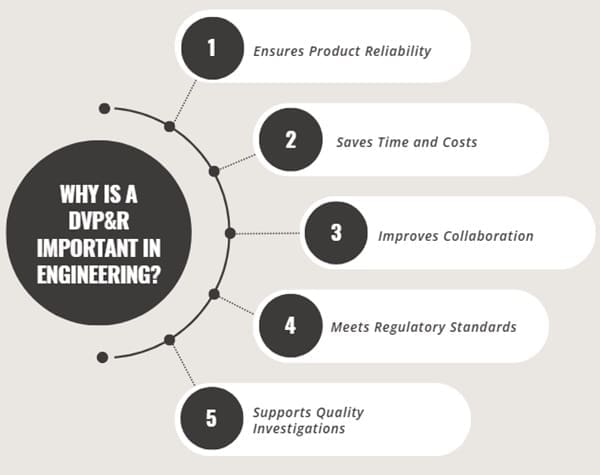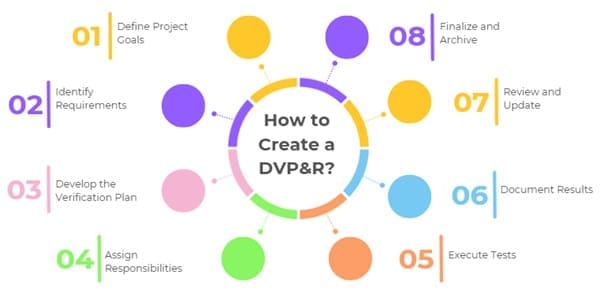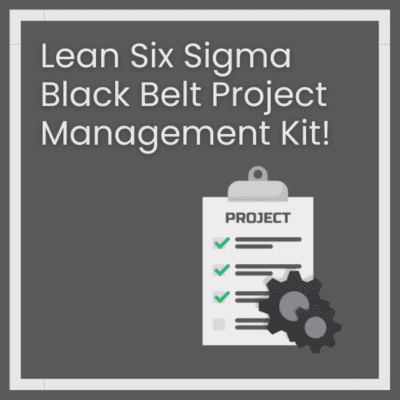A Design Verification Plan and Report (DVP&R) represents a systematic approach to validating that engineering designs meet specified requirements and performance criteria. This comprehensive document serves as both a roadmap for testing activities and a formal record of verification results, ensuring that products perform as intended before moving to production.
The DVP&R meaning encompasses a structured methodology that combines planning, execution, and documentation phases to verify design integrity. This process helps organizations identify potential issues early in the development cycle, reducing costs and improving product quality through systematic testing and validation.
Table of contents
What is a Design Verification Plan and Report (DVP&R)?
A Design Verification Plan and Report (DVP&R) is a structured document used in engineering to plan, execute, and document tests that verify a product, system, or component meets its design specifications and performance requirements. The “plan” outlines the tests to be conducted, while the “report” records the results, ensuring transparency and traceability.
Often referred to as DVP and R or DVPR, this tool is widely used in industries like automotive, aerospace, and manufacturing to ensure quality before mass production.
The DVP&R meaning lies in its ability to bridge the gap between design intent and real-world performance. By systematically testing a product against its requirements, it minimizes risks, reduces costly rework, and ensures compliance with standards like IATF 16949 or ISO 9001. For example, in automotive manufacturing, a DVP&R might verify that a new brake system meets safety and durability standards before it’s installed in vehicles.
Public, Onsite, Virtual, and Online Six Sigma Certification Training!
- We are accredited by the IASSC.
- Live Public Training at 52 Sites.
- Live Virtual Training.
- Onsite Training (at your organization).
- Interactive Online (self-paced) training,
The DVP Engineering Process

Design Requirements Analysis
The DVP engineering process begins with comprehensive analysis of design requirements, performance specifications, and customer expectations. This analysis identifies critical parameters that require verification and establishes the foundation for developing effective test plans.
Requirements analysis involves collaboration between design engineers, test engineers, and quality assurance teams to ensure complete understanding of verification needs. This collaborative approach helps identify potential issues early and develops consensus on verification strategies.
Moreover, requirements analysis should consider regulatory standards, industry best practices, and customer-specific requirements that may influence verification activities. This comprehensive approach ensures that verification plans address all relevant factors affecting product performance.
Test Planning and Resource Allocation
Test planning involves developing detailed procedures, selecting appropriate test methods, and allocating necessary resources for verification activities. This systematic approach ensures efficient execution and reliable results from verification testing.
Resource allocation includes personnel assignments, equipment requirements, facility needs, and budget considerations that support successful verification activities. Proper planning helps organizations optimize resource utilization and meet project timelines.
Additionally, test planning should address potential risks, contingency procedures, and change control processes that may be needed during verification activities. This proactive approach helps minimize disruptions and ensures successful completion of verification objectives.
Execution and Data Collection
The execution phase involves conducting planned verification activities according to established procedures and collecting data that demonstrates design performance. This systematic approach ensures reliable and reproducible results that support design validation.
Data collection procedures should include quality control measures, calibration requirements, and documentation standards that ensure accurate and traceable results. These procedures help maintain data integrity and support regulatory compliance requirements.
Furthermore, execution activities should include real-time monitoring, issue resolution procedures, and communication protocols that keep stakeholders informed about verification progress and any emerging issues.
Design Verification Plan vs Design Validation Plan
| Aspect | Design Verification Plan | Design Validation Plan |
| Purpose | Confirms design outputs meet design inputs and specifications | Confirms the final product meets user needs and intended use |
| Key Question | “Did we design the product right?” | “Did we design the right product?” |
| Timing | Conducted during development, before final product is built | Conducted after development, on production-equivalent units |
| Focus | Internal consistency: checks if design matches requirements | External fit: checks if product fulfills user expectations and real-world use |
| Typical Activities | Reviews, inspections, analysis, static testing, comparison to previous designs | User testing, field trials, dynamic testing, simulation under real-use conditions |
| Level of Testing | Unit, module, subsystem, and sometimes system level | System-level, often under actual or simulated operating conditions |
| Methods Used | Static methods (document review, analysis, inspections, some functional tests) | Dynamic methods (prototyping, user feedback, performance in real environments) |
| Outcome/Documentation | Verification reports showing each requirement is met | Validation reports showing product meets user needs and regulatory approval |
| Regulatory Role | Ensures compliance with technical and regulatory requirements | Provides evidence for regulatory bodies that product is safe and effective |
| Dependency | Can be performed on parts or the whole design at any stage | Performed only after successful verification of the complete design |
| Example | Checking if a medical device’s design output matches the technical specs | Testing if users can operate the device as intended in a clinical environment |
Also Read: What is 8D?
Why is a DVP&R Important in Engineering?

A DVP&R is more than just paperwork—it’s a cornerstone of quality management. Here’s why it’s crucial for DVP engineering:
- Ensures Product Reliability: By testing designs thoroughly, a DVP&R confirms that products perform as expected, reducing failures in the field.
- Saves Time and Costs: Identifying issues early prevents expensive redesigns or production delays, as noted by industry experts Quality-One.
- Improves Collaboration: A clear DVP&R fosters communication between engineering, quality, and project teams, ensuring everyone is aligned.
- Meets Regulatory Standards: It ensures compliance with industry regulations, such as those required by automotive OEMs like Stellantis.
- Supports Quality Investigations: The documented results serve as a reference for troubleshooting issues during a product’s lifecycle.
By using a design verification plan, companies can launch products with confidence, knowing they’ve been rigorously tested.
Key Components of a DVP&R
A DVP&R is structured to provide clarity and consistency. Here are its core elements, as outlined by sources like SixSigma.us and AutomotiveQual:
1. Header Information
- Project Details: Includes the project name, product, and team members.
- Document Control: Tracks version, date, and approvals for traceability.
2. Verification Plan (DVP)
- Test Number: A unique identifier for each test or analysis.
- Specification/Test Name: Describes the requirement being tested (e.g., “brake pressure resistance”).
- Method/Procedure: Details the test method, such as physical testing or finite element analysis (FEA).
- Acceptance Criteria: Defines pass/fail thresholds, ideally with quantifiable metrics.
- Sample Level: Specifies whether samples are prototypes, pre-production, or production parts.
- Sample Size: Indicates the number of samples tested.
- Scheduled Timing: Lists planned test dates.
3. Verification Report (R)
- Actual Timing: Records when tests were actually performed, which may differ from planned dates due to project changes.
- Sample ID: Tracks unique identifiers for tested samples.
- Test Results: Documents outcomes, including pass/fail status, raw data, and statistical analysis.
- Report Number: Links to detailed test reports for reference.
4. Additional Details
- Compliance Notes: Highlights critical characteristics or regulatory requirements.
- Corrective Actions: Notes any issues and steps to resolve them.
These components ensure a DVP&R is comprehensive, making it a vital tool for design verification plan execution.
Also Read: What is Error Proofing Process?
How to Create a DVP&R?

Creating a DVP&R requires careful planning and execution. Follow these steps to build an effective design verification plan and report:
Step 1: Define Project Goals
Clarify the product’s purpose and critical functions. For example, a medical device might need to meet FDA standards for safety and performance.
Step 2: Identify Requirements
List all design specifications, including quality, performance, and regulatory requirements. Use tools like DFMEA (Design Failure Mode and Effects Analysis) to identify potential failure modes.
Step 3: Develop the Verification Plan
Outline specific tests to verify each requirement. Specify methods (e.g., physical testing, simulations), sample sizes, and acceptance criteria. Ensure tests are measurable and aligned with standards.
Step 4: Assign Responsibilities
Designate team members for conducting tests, analyzing results, and documenting findings. Clear roles enhance accountability.
Step 5: Execute Tests
Perform the planned tests, using prototypes or production parts as specified. Maintain detailed records of conditions, such as sample level or testing environment.
Step 6: Document Results
Record test outcomes in the report section, including pass/fail status, raw data, and any deviations. Link to detailed reports if needed.
Step 7: Review and Update
Review the DVP&R with stakeholders to identify issues. Update the plan as the project evolves to reflect design changes or new requirements.
Step 8: Finalize and Archive
Once testing is complete, finalize the DVP&R and store it for future reference or quality investigations.
For a head start, download our free DVP&R template [internal link suggestion: /dvpr-template-download] to streamline your process.
DVP&R Example: Automotive Brake System
To illustrate, let’s explore a DVP&R example for a new automotive brake system:
- Project: Brake system for a compact SUV.
- Hazard: Brake failure under high pressure.
- Test Plan:
- Test 1: Pressure resistance test (Method: Hydraulic pressure simulation; Acceptance: No leaks at 200 bar; Sample: 5 pre-production units).
- Test 2: Durability test (Method: 10,000-cycle test; Acceptance: <2% wear; Sample: 3 production parts).
- Results:
- Test 1: All units passed with no leaks.
- Test 2: One unit showed 2.5% wear, requiring a design tweak.
- Corrective Action: Adjusted material composition to improve durability.
This DVP&R example shows how the tool identifies issues early, ensuring a reliable product.
Benefits of Using a DVP&R in Engineering
A DVP&R offers numerous advantages for DVP engineering projects:
- Clarity and Transparency: It provides a clear snapshot of testing progress, understandable by stakeholders, as noted by Quality-One.
- Risk Reduction: Early detection of design flaws prevents costly failures.
- Improved Efficiency: Structured planning avoids redundant tests, saving time and resources.
- Regulatory Compliance: Ensures adherence to standards like IATF 16949, critical in automotive and aerospace industries.
- Documentation for Future Use: Serves as a reference for quality investigations or future projects.
By integrating DVP&R into your workflow, you enhance product quality and streamline development.
Industries Using DVP&R
The design verification plan and report is widely used across industries where reliability and compliance are paramount:
- Automotive: Verifies components like engines or brakes meet safety standards.
- Aerospace: Ensures parts withstand extreme conditions, as seen in AS9100 standards.
- Medical Devices: Validates devices meet FDA or ISO 13485 requirements.
- Electronics: Confirms circuit boards or chips perform as designed.
- Manufacturing: Ensures production parts meet quality and performance specs.
No matter the industry, a DVP&R ensures products are fit for purpose.
Tools and Templates for DVP&R
Creating a DVP&R is easier with the right tools:
- Excel or Google Sheets: Simple and accessible for manual DVP&R templates.
- BowTieXP or e1ns: Specialized software for dynamic test planning and reporting.
- Intelex or MasterControl: Quality management systems with built-in DVP&R modules.
- AIIT Institute Templates: Free DVP&R templates for various industries
Challenges of DVP&R Implementation
While powerful, DVP&R implementation can face challenges:
- Complexity: Creating detailed plans for complex systems can be time-intensive.
- Resource Constraints: Testing requires equipment, samples, and skilled personnel.
- Subjectivity: Defining acceptance criteria can be subjective without clear metrics.
- Schedule Delays: Project changes may shift testing timelines.
Overcome these by using software, involving cross-functional teams, and setting clear, quantifiable criteria.
Also See: Best Lean Six Sigma Training in Raleigh
Best Practices for Effective DVP&R
To maximize your design verification plan and report, follow these tips:
- Align with Requirements: Ensure tests directly address design specifications.
- Use Quantifiable Metrics: Avoid subjective criteria; use numerical limits (e.g., “<2% wear”).
- Involve Stakeholders: Collaborate with engineering, quality, and project teams for comprehensive planning.
- Update Regularly: Adjust the plan to reflect design changes or new requirements.
- Leverage Software: Use tools like e1ns or Intelex to streamline documentation and tracking.
Frequently Asked Questions (FAQs) on DVP&R
What is a Design Verification Plan and Report (DVP&R)?
A DVP&R is a document that plans and records tests to verify a product meets its design specifications and performance requirements, ensuring quality before production.
Why is a DVP&R important in engineering?
It ensures product reliability, reduces risks, saves costs, meets regulatory standards, and provides clear documentation for quality assurance.
What industries use DVP&R?
Automotive, aerospace, medical devices, electronics, and manufacturing use DVP&R to verify product performance and compliance.
How do I create a DVP&R?
Define project goals, list requirements, plan tests, assign responsibilities, execute tests, document results, and review. Use our free template [internal link suggestion: /dvpr-template-download].
What’s the difference between DVP&R and design validation?
DVP&R verifies technical specifications, while design validation confirms the product meets user needs and intended use.
Final Words
A Design Verification Plan and Report (DVP&R) is a vital tool for ensuring product quality and reliability in engineering projects. By systematically planning and documenting tests, it bridges the gap between design intent and real-world performance, reducing risks and ensuring compliance. Whether you’re in automotive, aerospace, or electronics, adopting a DVP&R can save time, cut costs, and enhance your reputation.



















